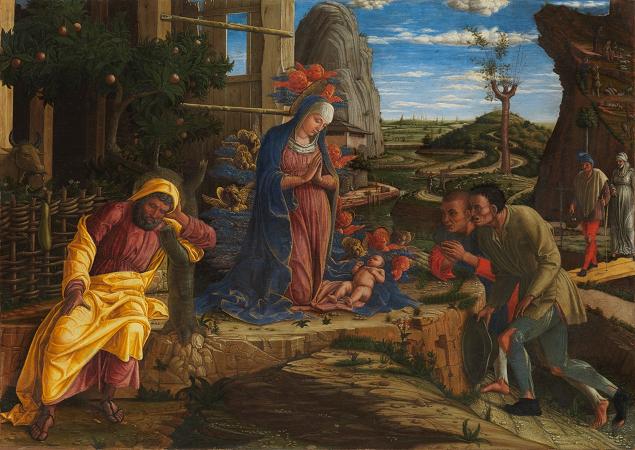Andrea Mantegna (1431 - 1506). Andrea Mantegna was an Italian painter, a student of Roman archeology, and son-in-law of Jacopo Bellini. Like other artists of the time, Mantegna experimented with perspective, e.g. by lowering the horizon in order to create a sense of greater monumentality. His flinty, metallic landscapes and somewhat stony figures give evidence of a fundamentally sculptural approach to painting. He also led a workshop that was the leading producer of prints in Venice before 1500. Mantegna was born in Isola di Carturo, Venetian Republic close to Padua, second son of a carpenter, Biagio. At the age of eleven he became the apprentice of Paduan painter Francesco Squarcione. Squarcione, whose original profession was tailoring, appears to have had a remarkable enthusiasm for ancient art, and a faculty for acting. Like his famous compatriot Petrarca, Squarcione was an ancient Rome enthusiast: he traveled in Italy, and perhaps also in Greece, collecting antique statues, reliefs, vases, etc., making drawings from them himself, then making available his collection for others to study. All the while, he continued undertaking works on commission, to which his pupils, no less than himself, contributed. As many as 137 painters and pictorial students passed through Squarcione's school, which had been established around 1440 and which became famous all over Italy. Padua attracted artists not only from the Veneto but also from Tuscany, such as Paolo Uccello, Filippo Lippi and Donatello; Mantegna's early career was shaped by impressions of Florentine works. At the time, Mantegna was said to be a favorite pupil of Squarcione, who taught him Latin and instructed him to study fragments of Roman sculpture. The master also preferred forced perspective, recollection of which may account for some of Mantegna's later innovations. However, at the age of seventeen Mantegna left Squarcione's workshop. He later claimed that Squarcione had profited from his work without sufficient payment. Mantegna's first work, now lost, was an altarpiece for the church of Santa Sofia in 1448. The same year he was called, together with Nicolo Pizolo, to work with a large group of painters entrusted with the decoration of the Ovetari Chapel in the transept of the church of the Eremitani. It is probable, however, that before this time some of the pupils of Squarcione, including Mantegna, had already begun the series of frescoes in the chapel of S. Cristoforo, in the church of Sant'Agostino degli Eremitani, which are today considered a masterpiece. After a series of coincidences, Mantegna finished most of the work alone, though Ansuino, who collaborated with Mantegna in the Ovetari Chapel, brought his style from the Forli school of painting. The now critical Squarcione carped about the earlier works of this series, illustrating the life of St James; he said the figures were like men made of stone, and should have been painted stone color. This series was almost entirely lost in the 1944 allied bombings of Padua. The most dramatic work of the fresco cycle was the work set in the worm's-eye view perspective, St. James Led to His Execution. The sketch for the St. Stephen fresco survived and is the earliest known preliminary sketch which still survives to compare with the corresponding fresco. The drawing shows proof that nude figures, which were later painted as clothed, were used in the conception of works during the Early Renaissance. In the preliminary sketch, the perspective is less developed and closer to a more average viewpoint however. Despite the authentic Classical look of the monument, it is not a copy of any known Roman structure. Mantegna also adopted the wet drapery patterns of the Romans, who took the form from the Greek invention, for the clothing of his figures, although the tense figures and interactions are derived from Donatello. Among the other early Mantegna frescoes are the two saints over the entrance porch of the church of Sant'Antonio in Padua, 1452, and the 1453 San Luca Altarpiece, with St. Luke and other saints, for the church of S. Giustina and now in the Brera Gallery in Milan. As the young artist progressed in his work, he came under the influence of Jacopo Bellini, father of the celebrated painters Giovanni Bellini and Gentile Bellini, and met his daughter Nicolosia. In 1453 Jacopo consented to a marriage between Nicolosia and Mantegna. Andrea seems to have been influenced by his old preceptor's strictures, although his later subjects, for example, those from the legend of St. Christopher, combine his sculptural style with a greater sense of naturalism and vivacity.
more...














